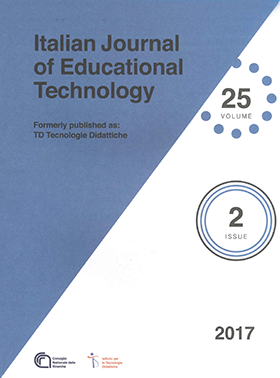Creare il giocatore computerizzato: un approccio collaborativo e coinvolgente per introdurre il pensiero computazionale combinando attività ‘unplugged’ e programmazione visiva
Contenuto principale dell'articolo
Abstract
Dettagli dell'articolo
Gli autori che pubblicano su questa rivista accettano le seguenti condizioni:
- Gli autori mantengono i diritti sulla loro opera e cedono alla rivista il diritto di prima pubblicazione dell'opera, contemporaneamente licenziata sotto una Licenza Creative Commons CC BY 4.0 Attribution 4.0 International License.
- Gli autori possono aderire ad altri accordi di licenza non esclusiva per la distribuzione della versione dell'opera pubblicata (es. depositarla in un archivio istituzionale o pubblicarla in una monografia), a patto di indicare che la prima pubblicazione è avvenuta su questa rivista.
- Gli autori possono diffondere la loro opera online (es. in repository istituzionali o nel loro sito web) prima e durante il processo di submission, poiché può portare a scambi produttivi e aumentare le citazioni dell'opera pubblicata (Vedi The effect of Open Access).
Riferimenti bibliografici
Armoni, M. (2011). The nature of CS in K--12 curricula: the roots of confusion. ACM Inroads, 2(4), 19- 20. doi:10.1145/2038876.2038883
Bell, T., Alexander, J., Freeman, I., & Grimley, M. (2009). Computer science unplugged: School students doing real computing without computers. The New Zealand Journal of Applied Computing and Information Technology, 13(1), 20-29. Retrieved from http://www.computingunplugged.org/sites/default/files/papers/Unplugged-JACIT2009submit.pdf
Bundy, A. (2007). Computational thinking is pervasive. Journal of Scientific and Practical Computing, 1(2), 67-69. Retrieved from http://www.spclab.com/publisher/journals/Vol1No2/N1.pdf
Dann, W. P., Cooper, S., & Pausch, R. (2011). Learning to Program with Alice (w/CD ROM). Upper Saddle River, NJ: Prentice Hall Press.
Faust, J. L., & Paulson, D. R. (1998). Active learning in the college classroom. Journal on Excellence in College Teaching, 9(2), 3-24. Retrieved from https://eric.ed.gov/?id=EJ595306
Gibson, B., & Bell, T. (2013, November). Evaluation of games for teaching computer science. In Proceedings of the 8th Workshop in Primary and Secondary Computing Education (pp. 51-60). New York, NY: ACM. doi:10.1145/2532748.2532751
Huang, T. (2001). Strategy game programming projects. Journal of Computing Sciences in Colleges, 16(4), 205-213. Retrieved from http://dl.acm.org/citation.cfm?id=378708
Ivanović, M., Budimac, Z., Radovanović, M., & Savić, M. (2015, June). Does the choice of the first programming language influence students’ grades?. In Proceedings of the 16th International Conference on Computer Systems and Technologies (pp. 305-312). New York, NY: ACM.
Kalelioğlu, F. (2015). A new way of teaching programming skills to K-12 students: Code. org. Computers in Human Behavior, 52, 200-210. doi:10.1016/j.chb.2015.05.047
Kölling, M. (2010). The Greenfoot programming environment. ACM Transactions on Computing Education (TOCE), 10(4), 14. doi:10.1145/1868358.1868361
Kordaki, M. (2012). Diverse categories of programming learning activities could be performed within Scratch. Procedia - Social and Behavioral Sciences, 46, 1162-1166. doi:10.1016/j.sbspro.2012.05.267
Lai, M., Luong, D., & Young, G. (2015, January). A Study of Kinesthetic Learning Activities Effectiveness in Teaching Computer Algorithms Within an Academic Term. In Proceedings of the International Conference on Frontiers in Education: Computer Science and Computer Engineering (FECS) (p. 44). Retrieved from http://search.proquest.com/openview/f4c2a3fdd27bff8cb819c9f69f32090 d/1?pq-origsite=gscholar&cbl=1976352
Lu, J. J., & Fletcher, G. H. (2009). Thinking about computational thinking. ACM SIGCSE Bulletin, 41(1), 260-264. doi:10.1145/1508865.1508959
Lye, S. Y., & Koh, J. H. L. (2014). Review on teaching and learning of computational thinking through programming: What is next for K-12?. Computers in Human Behavior, 41, 51-61. doi:10.1016/j. chb.2014.09.012
Maloney, J., Resnick, M., Rusk, N., Silverman, B., & Eastmond, E. (2010). The Scratch programming language and environment. ACM Transactions on Computing Education (TOCE), 10(4), 16. doi:10.1145/1868358.1868363
Prensky, M. (2005). Engage me or enrage me: What today’s learners demand. EDUCAUSE Review, 40(5). Retrieved from https://www.learntechlib.org/p/99184/
Sáez-López, J. M., Román-González, M., & Vázquez-Cano, E. (2016). Visual programming languages integrated across the curriculum in elementary school: A two year case study using “Scratch” in five schools. Computers & Education, 97, 129-141. doi:10.1016/j.compedu.2016.03.003
Sorva, J., Karavirta, V., & Malmi, L. (2013). A review of generic program visualization systems for introductory programming education. ACM Transactions on Computing Education (TOCE), 13(4), 15. doi:10.1145/2490822
Sung, H. Y., & Hwang, G. J. (2013). A collaborative game-based learning approach to improving students’ learning performance in science courses. Computers & Education, 63, 43-51. doi:10.1016/j. compedu.2012.11.019
Wilson, A., & Moffat, D. (2010). Evaluating scratch to introduce younger schoolchildren to programming. In J. Lawrance, & R. Bellamy (Eds.), Proceedings of the 22nd annual workshop of the psychology of programming interest group – PPIG2010, September 19–22, 2010 (pp. 64–74). Retrieved from https://www.researchgate.net/profile/Amanda_Wilson2/publication/266490101_Evaluating_Scratch_to_introduce_younger_schoolchildren_to.pdf
Wing, J. M. (2008). Computational thinking and thinking about computing. Philosophical transactions of the royal society of London A: mathematical, physical and engineering sciences, 366(1881), 3717-3725. doi:10.1098/rsta.2008.0118
Zhang, F., Kaufman, D., & Fraser, S. (2014). Using Video Games in Computer Science Education. European Scientific Journal, 10(22), 37-52. Retrieved from http://www.eujournal.org/index.php/esj/article/view/3904/3695

